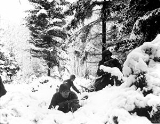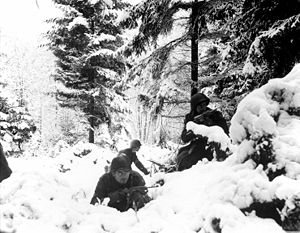
Hedgehog defence
Encyclopedia

War
War is a state of organized, armed, and often prolonged conflict carried on between states, nations, or other parties typified by extreme aggression, social disruption, and usually high mortality. War should be understood as an actual, intentional and widespread armed conflict between political...
fare, the hedgehog defence is a military tactic
Military tactics
Military tactics, the science and art of organizing an army or an air force, are the techniques for using weapons or military units in combination for engaging and defeating an enemy in battle. Changes in philosophy and technology over time have been reflected in changes to military tactics. In...
for defending against a mobile armoured attack, or blitzkrieg
Blitzkrieg
For other uses of the word, see: Blitzkrieg Blitzkrieg is an anglicized word describing all-motorised force concentration of tanks, infantry, artillery, combat engineers and air power, concentrating overwhelming force at high speed to break through enemy lines, and, once the lines are broken,...
. The defenders deploy in depth
Defence in depth
Defence in depth is a military strategy; it seeks to delay rather than prevent the advance of an attacker, buying time and causing additional casualties by yielding space...
in heavily fortified positions suitable for all-around defence. The attackers can penetrate between these "hedgehog
Hedgehog
A hedgehog is any of the spiny mammals of the subfamily Erinaceinae and the order Erinaceomorpha. There are 17 species of hedgehog in five genera, found through parts of Europe, Asia, Africa, and New Zealand . There are no hedgehogs native to Australia, and no living species native to the Americas...
s", but each position continues to fight on when surrounded. This keeps large numbers of attacking troops tied up, attacking the well-defended strongpoints, while allowing the defenders to successfully counterattack against the units that bypass these strongpoints with their own armored reserves by cutting them off from their supporting elements.
The tactic was proposed by General Maxime Weygand
Maxime Weygand
Maxime Weygand was a French military commander in World War I and World War II.Weygand initially fought against the Germans during the invasion of France in 1940, but then surrendered to and collaborated with the Germans as part of the Vichy France regime.-Early years:Weygand was born in Brussels...
during the Battle of France
Battle of France
In the Second World War, the Battle of France was the German invasion of France and the Low Countries, beginning on 10 May 1940, which ended the Phoney War. The battle consisted of two main operations. In the first, Fall Gelb , German armoured units pushed through the Ardennes, to cut off and...
in 1940. However Allied forces in 1940 were unable to successfully apply the tactic before they sustained heavy losses and France capitulated. The remaining forces which did apply the tactic were simply bypassed.
On the Eastern Front the German army used the tactic successfully during the Soviet winter advances, notably in the Battle of Moscow
Battle of Moscow
The Battle of Moscow is the name given by Soviet historians to two periods of strategically significant fighting on a sector of the Eastern Front during World War II. It took place between October 1941 and January 1942. The Soviet defensive effort frustrated Hitler's attack on Moscow, capital of...
in 1941, in the Second Rzhev-Sychevka Offensive in November 1942, and in the battle around Orel
Oryol
Oryol or Orel is a city and the administrative center of Oryol Oblast, Russia, located on the Oka River, approximately south-southwest of Moscow...
during Operation Saturn
Operation Saturn
Operation Saturn, revised as Operation Little Saturn, was a Red Army operation on the Eastern Front of World War II that led to battles in the northern Caucasus and Donets Basin regions of the Soviet Union from December 1942 to February 1943....
in February 1943. On the eastern front, Germans adopted the additional feature commonly associated with hedgehog defence—resupply of the strongpoints by air: particularly in the winter of 1941-42, the advanced "hedgehogs" effectively surrounded by the Soviets, such as the Demyansk pocket
Demyansk Pocket
The Demyansk Pocket was the name given for the encirclement of German troops by the Red Army around Demyansk , south of Leningrad, during World War II on the Eastern Front. The pocket existed mainly from 8 February-21 April 1942. A much smaller pocket was simultaneously surrounded in Kholm, about ...
, were supplied mainly by air. Although casualties were heavy, these strongpoints held up large numbers of attacking Soviet troops and prevented them from being deployed elsewhere—the successful defense of the Demyansk pocket, for example, helped stem the Soviet counteroffensive following the Battle of Moscow. Although aerial resupply reduced reliance on vulnerable ground transport, it inflicted enormous strain on the Luftwaffe
Luftwaffe
Luftwaffe is a generic German term for an air force. It is also the official name for two of the four historic German air forces, the Wehrmacht air arm founded in 1935 and disbanded in 1946; and the current Bundeswehr air arm founded in 1956....
. The successful holding of forward positions in these battles led Adolf Hitler
Adolf Hitler
Adolf Hitler was an Austrian-born German politician and the leader of the National Socialist German Workers Party , commonly referred to as the Nazi Party). He was Chancellor of Germany from 1933 to 1945, and head of state from 1934 to 1945...
to insist for the remainder of the war that static positions be held to the last man, but growing weakness of the Luftwaffe and increasing combat capabilities of the Soviet Air Force
Soviet Air Force
The Soviet Air Force, officially known in Russian as Военно-воздушные силы or Voenno-Vozdushnye Sily and often abbreviated VVS was the official designation of one of the air forces of the Soviet Union. The other was the Soviet Air Defence Forces...
made resupply of isolated strongpoints by air difficult. In particular, Hitler had hoped that the surrounded Stalingrad
Battle of Stalingrad
The Battle of Stalingrad was a major battle of World War II in which Nazi Germany and its allies fought the Soviet Union for control of the city of Stalingrad in southwestern Russia. The battle took place between 23 August 1942 and 2 February 1943...
could be turned into a giant hedgehog, tying up vast numbers of Soviet troops. After the Battle of Kursk
Battle of Kursk
The Battle of Kursk took place when German and Soviet forces confronted each other on the Eastern Front during World War II in the vicinity of the city of Kursk, in the Soviet Union in July and August 1943. It remains both the largest series of armored clashes, including the Battle of Prokhorovka,...
in 1943 the German army
German Army
The German Army is the land component of the armed forces of the Federal Republic of Germany. Following the disbanding of the Wehrmacht after World War II, it was re-established in 1955 as the Bundesheer, part of the newly formed West German Bundeswehr along with the Navy and the Air Force...
lacked the essential components of the tactic, the mobile armoured reserve and an air combat capability necessary to secure local air superiority for keeping open aerial supply corridor, thus losing the war.
Following the end of World War II, this tactic was successfully used in Southeast Asia by the French against the Viet Minh
Viet Minh
Việt Minh was a national independence coalition formed at Pac Bo on May 19, 1941. The Việt Minh initially formed to seek independence for Vietnam from the French Empire. When the Japanese occupation began, the Việt Minh opposed Japan with support from the United States and the Republic of China...
in the Battle of Na San
Battle of Na San
The Battle of Nà Sản was fought between French Union forces and the communist forces of the Việt Minh at Nà Sản, Sơn La Province, during the First Indochina War for control of the T’ai region ....
. The French suffered a disaster in the Battle of Dien Bien Phu
Battle of Dien Bien Phu
The Battle of Dien Bien Phu was the climactic confrontation of the First Indochina War between the French Union's French Far East Expeditionary Corps and Viet Minh communist revolutionaries. The battle occurred between March and May 1954 and culminated in a comprehensive French defeat that...
when General Giap
Vo Nguyen Giap
Võ Nguyên Giáp is a retired Vietnamese officer in the Vietnam People’s Army and a politician. He was a principal commander in two wars: the First Indochina War and the Vietnam War...
deployed unexpectedly heavy concentrations of anti-aircraft artillery around the French garrison and successfully disrupted aerial resupply. Hedgehog defense was central in U.S. Marines' successful defense of Khe Sanh
Battle of Khe Sanh
The Battle of Khe Sanh was conducted in northwestern Quang Tri Province, Republic of Vietnam , between 21 January and 9 July 1968 during the Vietnam War...
against the PAVN.
A notable example of modern hedgehog defence is the Battle of Vukovar
Battle of Vukovar
The Battle of Vukovar was an 87-day siege of Vukovar in eastern Croatia by the Yugoslav People's Army , supported by various paramilitary forces from Serbia, between August and November 1991. Before the Croatian War of Independence the Baroque town was a prosperous, mixed community of Croats,...
during the Croatian War of independence
Yugoslav wars
The Yugoslav Wars were a series of wars, fought throughout the former Yugoslavia between 1991 and 1995. The wars were complex: characterized by bitter ethnic conflicts among the peoples of the former Yugoslavia, mostly between Serbs on the one side and Croats and Bosniaks on the other; but also...
, in which a small, ill-armed but determined Croatia
Croatia
Croatia , officially the Republic of Croatia , is a unitary democratic parliamentary republic in Europe at the crossroads of the Mitteleuropa, the Balkans, and the Mediterranean. Its capital and largest city is Zagreb. The country is divided into 20 counties and the city of Zagreb. Croatia covers ...
n resistance kept a larger, heavily equipped — but less-motivated - Yugoslav army
Yugoslav Army
Aside from the Yugoslav People's Army, the terms Yugoslav Army, Army of Yugoslavia, or Military of Yugoslavia may refer to:* Yugoslav Partisans , the Yugoslav resistance army during World War II...
at hold; buying precious time for the fledgling Republic of Croatia to organize their own armed forces
Armed forces
The armed forces of a country are its government-sponsored defense, fighting forces, and organizations. They exist to further the foreign and domestic policies of their governing body, and to defend that body and the nation it represents from external aggressors. In some countries paramilitary...
. Another, ultimately less successful application, was the Iraqi military strategy during the first Gulf War
Gulf War
The Persian Gulf War , commonly referred to as simply the Gulf War, was a war waged by a U.N.-authorized coalition force from 34 nations led by the United States, against Iraq in response to Iraq's invasion and annexation of Kuwait.The war is also known under other names, such as the First Gulf...
to fortify Kuwait
Kuwait
The State of Kuwait is a sovereign Arab state situated in the north-east of the Arabian Peninsula in Western Asia. It is bordered by Saudi Arabia to the south at Khafji, and Iraq to the north at Basra. It lies on the north-western shore of the Persian Gulf. The name Kuwait is derived from the...
and create an extensive 'hedgehog' defensive position. These forward defensive positions were staffed by its elite Republican Guard. The dug-in forces complemented in-depth defense features such as minefields, tank traps, fire trenches and other trench and bunker warfare.

